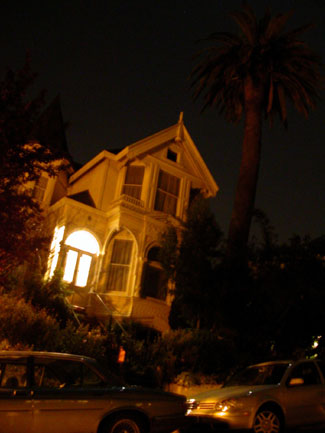Nikon Coolpix 2500: Handy 2-Megapixel Point-and-Shoot with Cool Design

Fine Firmware
The Coolpix 2500 has first-class firmware that will delight most non-technical photographers, as well as users who just want a camera that shoots pictures with minimal fuss. It offers three modes: Automatic, Manual, and Scene.
Automatic mode is what it sounds like: You turn the camera on, point it, and press the shutter button. Some anonymous Nikon think tank has imbued the Coolpix with essential elements of a photographer’s brain, that decide what’s important in the picture, what’s not, and how to expose the image. Usually, the Coolpix’s guesses are pretty good (see figure 3).

Figure 3: The automatic mode is usually pretty accurate in guessing the correct exposure for a scene.
The biggest problem with automatic mode is the camera’s nearest-object auto-focus, which will often home in on some unimportant foreground detail. The workaround to this is to pre-focus on the subject by depressing the shutter button half way, then to recompose the shot before tripping the shutter. One of the few complaints I had with the Coolpix was the slow focusing. I would often wait several seconds, blowing a chance at a good shot, while the Coolpix struggled to determine proper focus.
In addition to Automatic mode, the Coolpix lets you choose from 12 pre-programmed modes by pushing the Scene button. These include exposure and focus compensation for various types of lighting or action. For example, the Night Portrait mode balances a long exposure for background lighting with a red-eye-reduction fill flash to properly expose a foreground subject (see figure 4); the Beach/Snow mode compensates for strong ambient and reflected lighting (see figure 5), and resists the temptation of most camera metering to underexpose the shot in this situation; and the Closeup mode sets the lens to focus at very short macro distances (as little as 1.6 inches); while the Museum mode turns off the flash, and turns on the Best Shot Selector, which shoots multiple images, saving the one with the sharpest focus.

Figure 4: Nikon’s Night mode handles both background lighting and foreground exposure in low-light situations.

Figure 5: Beach/Snow mode adjusts for reflected light.
While these Scene modes won’t get perfect exposures in every situation, for the novice photographer, or the photographer on the run, they’re likely to do a great job of getting balanced exposures in most situations.
The Coolpix has a “Manual” mode, but rather than providing aperture and shutter controls, this mode lets you manually set the +/- Exposure compensation, Best Shot Selector, sharpening level, flash type, and color balance, to effectively create a custom Scene mode of your own choosing. Most users of the Coolpix will probably opt to shoot in Automatic mode, occasionally bumping in the exposure compensation a third of a stop or two, to tweak the results of automatic exposure, or switching into one of the Scene modes. The Manual mode is there for really unusual lighting situations, or to accommodate creative moments.
This article was last modified on January 18, 2023
This article was first published on April 23, 2002



